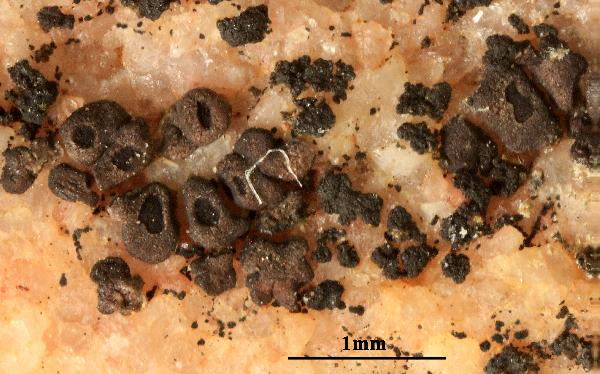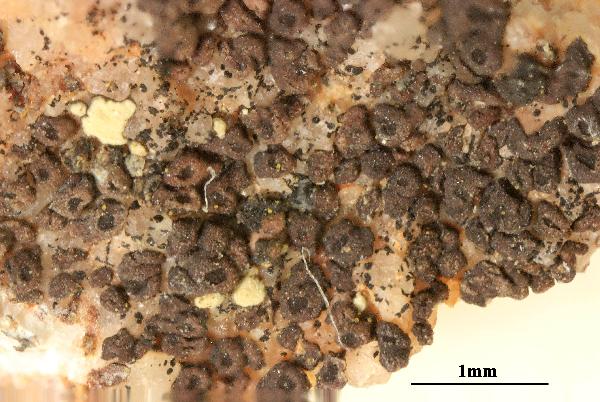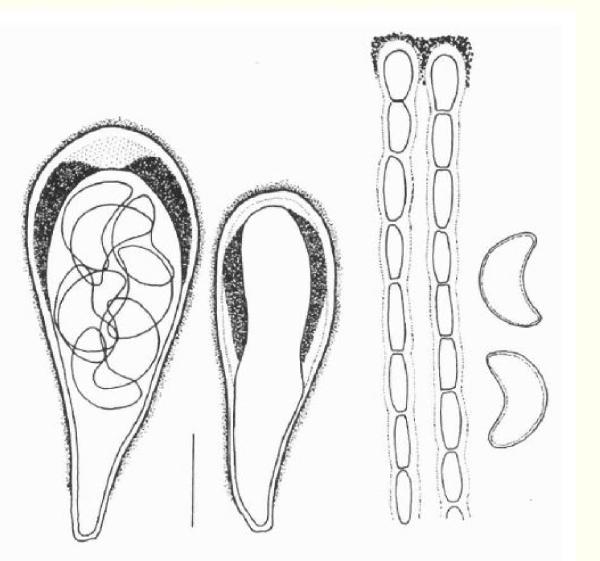Harpidium rutilans Körb.
Syst. Lich. Germ.: 157, 1855.
Synonyms: Zeora rutilans Flot. nom. nud.
Description: Thallus crustose, episubstratic, dark reddish brown, areolate, the areoles contiguous, angular, 0.2-0.5(-0.9) mm wide, the peripheral ones slightly elongate, up to 1.1 mm long, forming small, subplacodioid, up to 1 cm wide rosettes, without a distinct pro- or hypothallus. In section the thallus is homoiomerous and pseudoparenchymatous throughout, often overlain by a thin epinecral layer, 130-140 mm thick, the hyphae with more or less isodiametrical, 5-8 mm wide cells. Apothecia pycnoascocarps (developing from pycnidia), lecanorine-aspicilioid, 0.1-0.3 mm across, at first punctiform, then with an expanded disc, immersed in the areoles (usually 1 per areole) with a dark reddish brown, sometimes marginally slightly pruinose disc, and a very thin, finally often excluded thalline margin. Proper exciple poorly developed; epithecium pale reddish brown, K+ blue-purple, K/I+ blue; hymenium colourless, 40-50 mm high, K/I+ blue; paraphyses strongly moniliform, branched in upper part, the apical cells not swollen; hypothecium colourless, opaque, 40-45 mm thick. Asci 8-spored, subglobose, unitunicate-rostrate, the wall composed of an outer, non-expansible and an inner, expansible layer surrounding the protoplast as an amyloid collar, which expands during spore release into a long, tapering rostrum, the outer wall layer strongly amyloid. Ascospores 1-celled, hyaline, narrowly ellipsoid, reniform, allantoid to lunate, rarely shortly sigmoid, twisted in the asci, (8-)9.5-15(-17) x (3-)3.5–6(–6.5) μm. Photobiont chlorococcoid. Spot tests: thallus K+ blue-purple, C-, KC-, P-, UV-, I+ reddish. Chemistry: without lichen substances.
Growth form: Crustose
Substrata: rocks
Photobiont: green algae other than Trentepohlia
Reproductive strategy: mainly sexual
On otherwise dry surfaces with short periods of water seepage after rain
Commonnes-rarity: (info)
Alpine belt: absent
Subalpine belt: extremely rare
Montane belt: extremely rare
Dry submediterranean belt: very rare
Humid submediterranean belt: absent
Padanian area: absent
pH of the substrata:
1 2 3 4 5
Solar irradiation:
1 2 3 4 5
Aridity:
1 2 3 4 5
Eutrophication:
1 2 3 4 5
Poleotolerance:
0 1 2 3
Altitudinal distribution:
1 2 3 4 5 6
Rarity
absent
extremely rare
very rare
rare
rather rare
rather common
common
very common
extremely common
Loading data...
Occurrence data
Predictive map

Felix Schumm - CC BY-4.0
[VZR45], Hispania. Castelló, montes Serra d'Espadá, prope urbem
Azurbar, in sinu Mosquera dicto, 620 m. Ad saxa quarcitica. Leg. V.
Calatayud, 19.2.1992, det V. Calatayud & E. Barreno. EX A. VEZDA:
LICHENES RARIORES EXSICCATI NR. 45.

Felix Schumm - CC BY-4.0
[VZR45], Hispania. Castelló, montes Serra d'Espadá, prope urbem
Azurbar, in sinu Mosquera dicto, 620 m. Ad saxa quarcitica. Leg. V.
Calatayud, 19.2.1992, det V. Calatayud & E. Barreno. EX A. VEZDA:
LICHENES RARIORES EXSICCATI NR. 45.

P.L. Nimis; Owner: Department of Life Sciences, University of Trieste
Herbarium: TSB (16615)
2001/11/24
Growth form: Crustose
Substrata: rocks
Photobiont: green algae other than Trentepohlia
Reproductive strategy: mainly sexual
On otherwise dry surfaces with short periods of water seepage after rain
Commonnes-rarity: (info)
Alpine belt: absent
Subalpine belt: extremely rare
Montane belt: extremely rare
Dry submediterranean belt: very rare
Humid submediterranean belt: absent
Padanian area: absent
pH of the substrata:
| 1 | 2 | 3 | 4 | 5 |
Solar irradiation:
| 1 | 2 | 3 | 4 | 5 |
Aridity:
| 1 | 2 | 3 | 4 | 5 |
Eutrophication:
| 1 | 2 | 3 | 4 | 5 |
Poleotolerance:
| 0 | 1 | 2 | 3 |
Altitudinal distribution:
| 1 | 2 | 3 | 4 | 5 | 6 |
Rarity
absent
extremely rare
very rare
rare
rather rare
rather common
common
very common
extremely common
Loading data...
Occurrence data
Predictive map

Felix Schumm - CC BY-4.0
[VZR45], Hispania. Castelló, montes Serra d'Espadá, prope urbem Azurbar, in sinu Mosquera dicto, 620 m. Ad saxa quarcitica. Leg. V. Calatayud, 19.2.1992, det V. Calatayud & E. Barreno. EX A. VEZDA: LICHENES RARIORES EXSICCATI NR. 45.

Felix Schumm - CC BY-4.0
[VZR45], Hispania. Castelló, montes Serra d'Espadá, prope urbem Azurbar, in sinu Mosquera dicto, 620 m. Ad saxa quarcitica. Leg. V. Calatayud, 19.2.1992, det V. Calatayud & E. Barreno. EX A. VEZDA: LICHENES RARIORES EXSICCATI NR. 45.










